Pallav Kumar Bera
Identification of High Impedance Faults Utilizing Recurrence Plots
Mar 04, 2025Abstract:This paper presents a systematic approach to detecting High Impedance Faults (HIFs) in medium voltage distribution networks using recurrence plots and machine learning. We first simulate 1150 internal faults, including 300 HIFs, 1000 external faults, and 40 normal conditions using the PSCAD/EMTDC software. Key features are extracted from the 3-phase differential currents using wavelet coefficients, which are then converted into recurrence matrices. A multi-stage classification framework is employed, where the first classification stage identifies internal faults, and the second stage distinguishes HIFs from other internal faults. The framework is evaluated using accuracy, precision, recall, and F1 score. Tree-based classifiers, particularly Random Forest and Decision Tree, achieve superior performance, with 99.24% accuracy in the first stage and 98.26% in the second. The results demonstrate the effectiveness of integrating recurrence analysis with machine learning for fault detection in power distribution networks.
A Hybrid Intelligent System for Protection of Transmission Lines Connected to PV Farms based on Linear Trends
Jun 19, 2024Abstract:Conventional relays face challenges for transmission lines connected to inverter-based resources (IBRs). In this article, a single-ended intelligent protection of the transmission line in the zone between the grid and the PV farm is suggested. The method employs a fuzzy logic and random forest (RF)-based hybrid system to detect faults based on combined linear trend attributes of the 3-phase currents. The fault location is determined and the faulty phase is detected. RF feature selection is used to obtain the optimal linear trend feature. The performance of the methodology is examined for abnormal events such as faults, capacitor and load-switching operations simulated in PSCAD/EMTDC on IEEE 9-bus system obtained by varying various fault and switching parameters. Additionally, when validating the suggested strategy, consideration is given to the effects of conditions such as the presence of double circuit lines, PV capacity, sampling rate, data window length, noise, high impedance faults, CT saturation, compensation devices, evolving and cross-country faults, and far-end and near-end faults. The findings indicate that the suggested strategy can be used to deal with a variety of system configurations and situations while still safeguarding such complex power transmission networks.
Autoregressive Coefficients based Intelligent Protection of Transmission Lines Connected to Type-3 Wind Farms
Oct 05, 2023Abstract:Protective relays can mal-operate for transmission lines connected to doubly fed induction generator (DFIG) based large capacity wind farms (WFs). The performance of distance relays protecting such lines is investigated and a statistical model based intelligent protection of the area between the grid and the WF is proposed in this article. The suggested method employs an adaptive fuzzy inference system to detect faults based on autoregressive (AR) coefficients of the 3-phase currents selected using minimum redundancy maximum relevance algorithm. Deep learning networks are used to supervise the detection of faults, their subsequent localization, and classification. The effectiveness of the scheme is evaluated on IEEE 9-bus and IEEE 39-bus systems with varying fault resistances, fault inception times, locations, fault types, wind speeds, and transformer connections. Further, the impact of factors like the presence of type-4 WFs, double circuit lines, WF capacity, grid strength, FACTs devices, reclosing on permanent faults, power swings, fault during power swings, voltage instability, load encroachment, high impedance faults, evolving and cross-country faults, close-in and remote-end faults, CT saturation, sampling rate, data window size, synchronization error, noise, and semi-supervised learning are considered while validating the proposed scheme. The results show the efficacy of the suggested method in dealing with various system conditions and configurations while protecting the transmission lines that are connected to WFs.
Data-driven Protection of Transformers, Phase Angle Regulators, and Transmission Lines in Interconnected Power Systems
Feb 08, 2023



Abstract:This dissertation highlights the growing interest in and adoption of machine learning (ML) approaches for fault detection in modern power grids. Once a fault has occurred, it must be identified quickly and preventative steps must be taken to remove or insulate it. As a result, detecting, locating, and classifying faults early and accurately can improve safety and dependability while reducing downtime and hardware damage. ML-based solutions and tools to carry out effective data processing and analysis to aid power system operations and decision-making are becoming preeminent with better system condition awareness and data availability. Power transformers, Phase Shift Transformers or Phase Angle Regulators, and transmission lines are critical components in power systems, and ensuring their safety is a primary issue. Differential relays are commonly employed to protect transformers, whereas distance relays are utilized to protect transmission lines. Magnetizing inrush, overexcitation, and current transformer saturation make transformer protection a challenge. Furthermore, non-standard phase shift, series core saturation, low turn-to-turn, and turn-to-ground fault currents are non-traditional problems associated with Phase Angle Regulators. Faults during symmetrical power swings and unstable power swings may cause mal-operation of distance relays and unintentional and uncontrolled islanding. The distance relays also mal-operate for transmission lines connected to type-3 wind farms. The conventional protection techniques would no longer be adequate to address the above challenges due to limitations in handling and analyzing massive amounts of data, limited generalizability, incapability to model non-linear systems, etc. These limitations of differential and distance protection methods bring forward the motivation of using ML in addressing various protection challenges.
Detection of High Impedance Faults in Microgrids using Machine Learning
Nov 04, 2022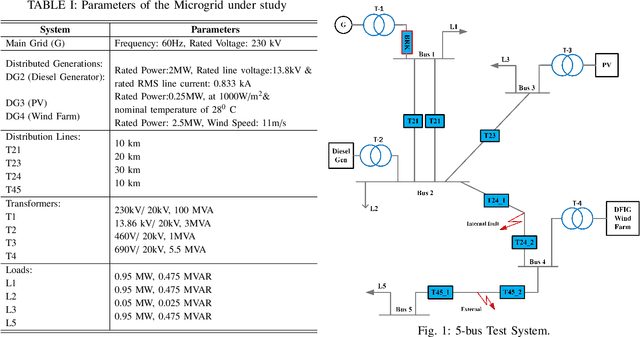
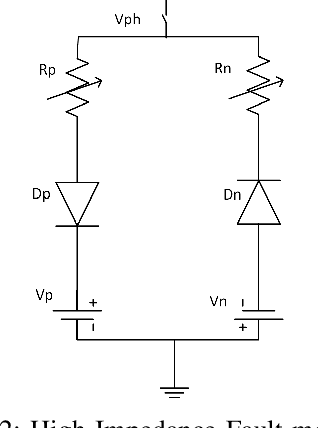
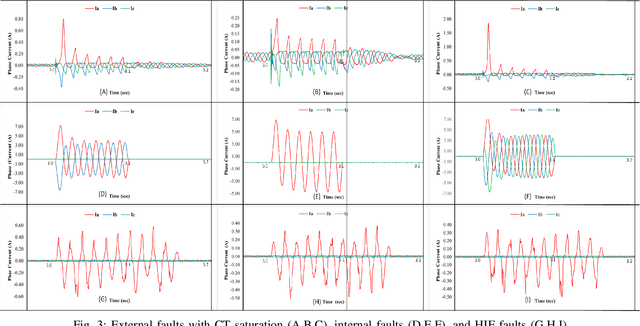

Abstract:This article presents differential protection of the distribution line connecting a wind farm in a microgrid. Machine Learning (ML) based models are built using differential features extracted from currents at both ends of the line to assist in relaying decisions. Wavelet coefficients obtained after feature selection from an extensive list of features are used to train the classifiers. Internal faults are distinguished from external faults with CT saturation. The internal faults include the high impedance faults (HIFs) which have very low currents and test the dependability of the conventional relays. The faults are simulated in a 5-bus system in PSCAD/EMTDC. The results show that ML-based models can effectively distinguish faults and other transients and help maintain security and dependability of the microgrid operation.
Intelligent Protection & Classification of Transients in Two-Core Symmetric Phase Angle Regulating Transformers
Jun 17, 2020
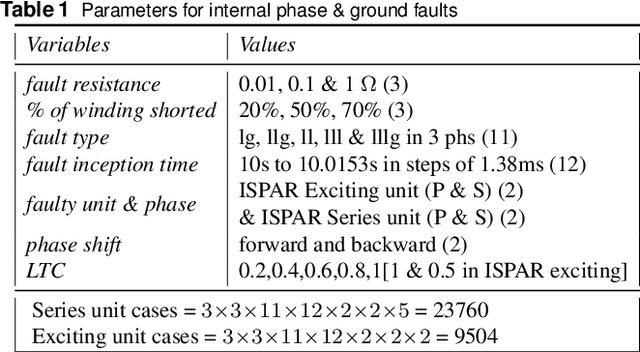
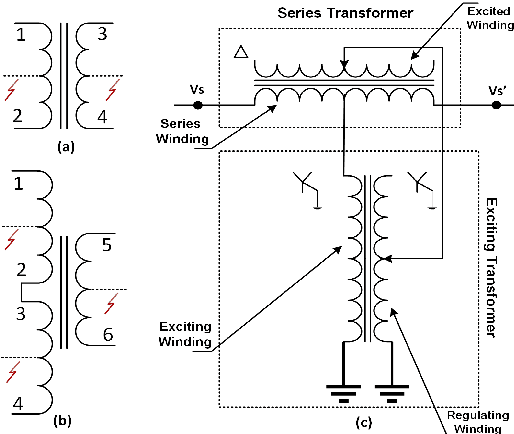
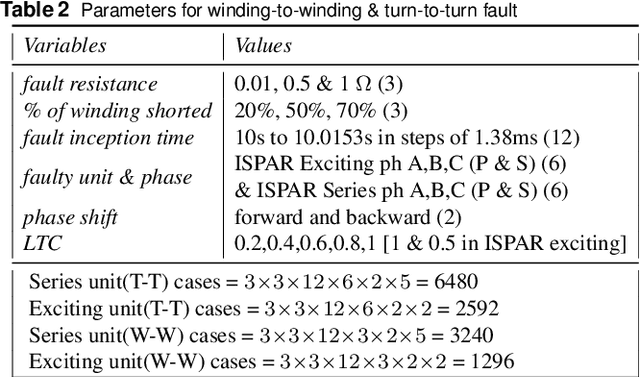
Abstract:This paper investigates the applicability of time and time-frequency features based classifiers to distinguish internal faults and other transients - magnetizing inrush, sympathetic inrush, external faults with current transformer saturation, and overexcitation - for Indirect Symmetrical Phase Angle Regulating Transformers (ISPAR). Then the faulty transformer unit (series/exciting) of the ISPAR is located, or else the transient disturbance is identified. An event detector detects variation in differential currents and registers one-cycle of 3-phase post transient samples which are used to extract the time and time-frequency features for training seven classifiers. Three different sets of features - wavelet coefficients, time-domain features, and combination of time and wavelet energy - obtained from exhaustive search using Decision Tree, random forest feature selection, and maximum Relevance Minimum Redundancy are used. The internal fault is detected with a balanced accuracy of 99.9%, the faulty unit is localized with balanced accuracy of 98.7% and the no-fault transients are classified with balanced accuracy of 99.5%. The results show potential for accurate internal fault detection and localization, and transient identification. The proposed scheme can supervise the operation of existing microprocessor-based differential relays resulting in higher stability and dependability. The ISPAR is modeled and the transients are simulated in PSCAD/EMTDC by varying several parameters.
Identification of Internal Faults in Indirect Symmetrical Phase Shift Transformers Using Ensemble Learning
Nov 12, 2018



Abstract:This paper proposes methods to identify 40 different types of internal faults in an Indirect Symmetrical Phase Shift Transformer (ISPST). The ISPST was modeled using Power System Computer Aided Design (PSCAD)/ Electromagnetic Transients including DC (EMTDC). The internal faults were simulated by varying the transformer tapping, backward and forward phase shifts, loading, and percentage of winding faulted. Data for 960 cases of each type of fault was recorded. A series of features were extracted for a, b, and c phases from time, frequency, time-frequency, and information theory domains. The importance of the extracted features was evaluated through univariate tests which helped to reduce the number of features. The selected features were then used for training five state-of-the-art machine learning classifiers. Extremely Random Trees and Random Forest, the ensemble-based learners, achieved the accuracy of 98.76% and 97.54% respectively outperforming Multilayer Perceptron (96.13%), Logistic Regression (93.54%), and Support Vector Machines (92.60%)
 Add to Chrome
Add to Chrome Add to Firefox
Add to Firefox Add to Edge
Add to Edge